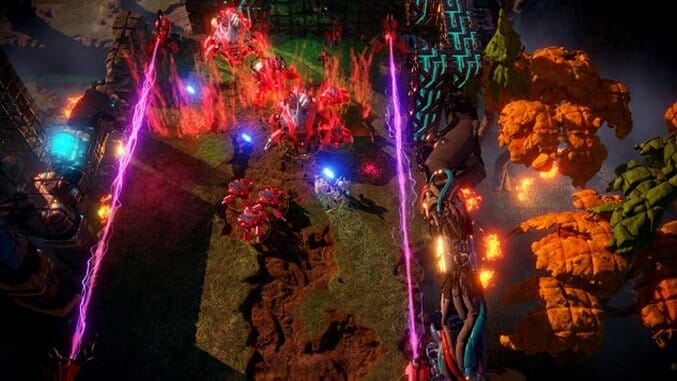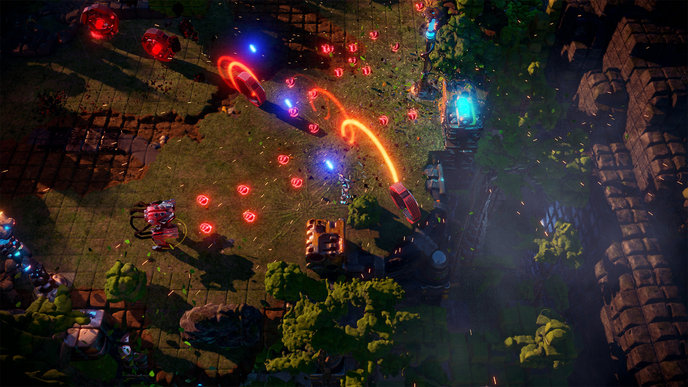
In 1981, an ambitious 26 year old programmer burst onto the burgeoning game development scene with side-scrolling, shoot ‘em up arcade game called Defender. Just a year later, the same programmer, California-born Eugene Jarvis, launched 2D shoot ‘em up, Robotron: 2084. And in the early ‘90s, Jarvis—not Tony Stark’s British AI—released cult classic, twin-stick shooter, Smash TV. It was these three games that inspired developer Housemarque to craft its latest sci-fi, back-to-basics shooter, Nex Machina, which Jarvis served as a creative consultant on.
Unfortunately, while Housemarque is known for creating solid videogame experiences, inspiration only carries so much weight. Nex Machina is just another beautiful, trite and underwhelming game in the prolific developer’s catalogue. And that’s a problem.
Nex Machina’s flimsy narrative is similar to that of Jarvis’s 1982 arcade title, Robotron: humanity is on its last leg and it’s up to you, a souped-up space fighter capable of collecting and swapping power-ups, to save whatever is left of it from the clutches of killer robots created by, you guessed it, humans. This trope, dubbed “killer robot” by TV Tropes, is incredibly bromidic and only serves as a catalyst to set the gameplay loop in motion. Although Housemarque is not known for complex, engaging storytelling in its games, Nex Machina suggests that your actions have meaning. When sub-objectives are completed (destroying beacons, eliminating visitors, obliterating disruptors, etc.) a female voice exclaims said objective is done. (“All humans saved,” for example.) When it comes down to it though, none of these objectives matter. So long as you get to the next level, it is unimportant how many beacons are destroyed or humans saved. Each of these sub-objectives, regrettably, function only as point bonuses and multipliers—and nothing more. In their interpretation of the far-future, human lives are merely worth increasing your score.
If you’re at all familiar with most of Housemarque’s other titles—Alienation, Dead Nation and its most notable, Super Stardust—then you already know how to play and what to expect from Nex Machina. It is a sci-fi, top-down, twin-stick shooter that plays similarly to that of Alienation and Dead Nation. So similar, in fact, that the three games could be palette swaps of one another. In shoot ‘em ups, it is important that there is no latency between the push of a button and a character’s actions, and it is equally important that the game is simply fun to play. Thankfully, Housemarque nails the controls here, as every button press has an almost immediate response. This means that if your superb run goes awry and you die—which you will, a lot—you’ll only have yourself to blame. While this elicits frustration and a prevalent echoing of the “#GitGud” mentality, Nex Machina can be extremely rewarding when you stumble upon the right power-ups, allowing you to swiftly clear levels like the souped-up space fighter you’re supposed to be. If you can get the right power-ups, that is.
Though not exactly procedurally generated, there is a bit of randomization that occurs in Nex Machina. This randomization is seen in the frequency and location of the disruptors and the power-ups. These power-ups—dash explosion, detonator, laser, rocket, shield, sword, triple dash, and the like—can and will make or break a run, and you will drop a single power-up each time you inevitably die. Death happens swiftly, as a single touch from the enemy will cause you to explode in a chandelier of pink lasers, dropping a power-up. The type of power-up dropped is randomized, but it can be retrieved at the location where you died. However, if you lose all of your five lives during a run and decide to continue, everything you had will be lost and the power-ups will randomize again. While it makes sense to lose everything once all lives are expended, performing a flawless run is less about skill and more about serendipity. This contradicts the level of skill Nex Machina expects from the player: because you can never expect the same thing from each run, it is both difficult and exasperating to repeat a level. And, as you might expect, some power-ups are far more effective than others (which is unfortunate because each power-up is unique and fits well within Housemarque’s self-dubbed “cablepunk”—a darker take on cyberpunk—aesthetic).
There’s no denying that Nex Machina is beautiful. Its cyberpunk world is brimming with color: neon blues and reds, vibrant greens and pinks, flashy yellows and whites. Performance is top-notch; I encountered no frame drops or stuttering, which is both important and necessary in a bullet-hell disguised as a shoot ‘em up. In typical Housemarque fashion, there are particle effects all over the place. While the technology behind the studio’s game is impressive—Housemarque use an amalgam of voxel technology and a volumetric rendering technique known as Signed Distance Fields—beauty alone isn’t enough to carry Nex Machina out of its overbearing and frankly unoriginal design, especially when just about every game in Housemarque’s catalog is incessantly labeled “beautiful” or “graphically impressive.” Perhaps toning down the particle effects or taking more of a risk with the cyberpunk theme would’ve helped elevate Nex Machina from the crowd of analogous cyberpunk games popping up everywhere.
Still, there is plenty of fun to be had with Nex Machina. The responsive, tight controls and simple, pick-up-and-play premise makes this Housemarque title perhaps the most accessible in the prestigious developer’s library. Their pedigree to construct visually enrapturing games is on full display here, with Nex Machina the most visually stunning game the studio has put out to date. However, to call Jarvis’s 1982 title Robotron: 2084 an inspiration is an understatement: Nex Machina is almost a duplicate, a modernization of a game that came out nearly three and a half decades ago. And while technology has significantly advanced in that period, so too have player expectations. Nex Machina doesn’t deliver anything but a particle effect smorgasbord and little else.
Nex Machina was developed and published by Housemarque. Our review is based on the PlayStation 4 version. It is also available for PC.
Jeremy Winslow is a Californian critic and essayist with big glasses who furiously types into WordPress and yells into the ether. He’s written for Feminist Frequency, GameSpot and more, and co-launched the small entertainment website Ground Punch. Listen to him yell on Twitter. Or don’t. That’s fine.

